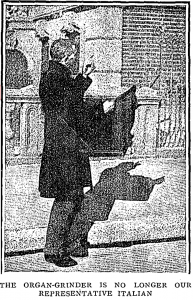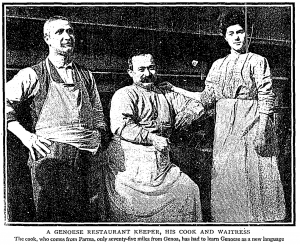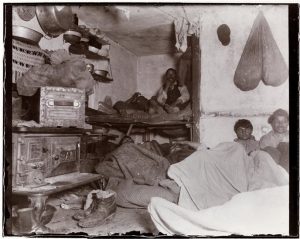



This article contains a mix of illustrations of Italian laborers and a description of perceptions of Italians in America. The pictures are of various Italians who, the author describes, as representative or non-representative of the new Italian immigrant class. The pictures range from subway workers to cooks. They describe the differences between Italians and how people who are all labelled the same by Americans are, in fact, vastly different from one another. The article mirrors the same sentiments, addressing how Italians from regions located geographically close can be extraordinarily different, even going as far to say that the languages between different regions are entirely different. The customs of the regions are different from cooking to cultural thought and a history of how this came to be through the division of states is explained. The author explains that not all immigrants stay permanently, and it seems to be dependent on the skill level and literacy of the Italians. Highlighted is the discrimination taking place at the housing and judicial levels where Italians are often convicted without due process and resigned to live in dilapidated housing that is never improved.
BELLAIRE, OHIO, JANUARY 10th˙ 1926
MY ADORED DAUGHTER,
I’VE RECEIVED YOUR LAST ONE DATED DECEMBER 14TH OF LAST YEAR, AND I DON’T UNDERSTAND WHY THERE WAS SUCH A LONG DELAY.
IN YOUR LETTER, YOU WERE EXPRESSING YOUR TENDERNESS AND THE AFFECTION THAT YOU HAVE FOR YOUR FAR-AWAY PARENT. YOUR EXPRESSIONS AND YOUR GOOD WISHES FILLED ME WITH JOY. THANKS, MY DEAR MARY, THANKS.
I’M FAIRLY FINE WITH YOUR BROTHERS, WHO ARE VERY BRATY AND TAKE ADVANTAGE OF MY GOOD NATURE.
LITTLE JOHN IS A COMPLETE ARTIST. THE WAY HE HAS PROGRESSED IN HIS DRAWINGS IS SHOCKING EVERYONE, GIVEN HIS TENDER AGE. FROM SUNRISE TO SUNSET, HE DOES NOTHING BUT PAINT ANF EVEN WHEN WE’RE IN CHURCH, HE WOULD LIKE TO DRAW THE PRIEST WHILE HE’S SAYING THE MASS. WHAT A MISCHIEVOUS ONE! IF HE WILL LIVE AND HAVE THE GOOD HEALTH, HE WILL BE ABLE TO EARN HIS LIVING IN NO TIME. I’M SENDING YOU SOME OF HIS SKETCHES THAT HE MAKES AT A TERRIFIC SPEED. I HAVEN’T BEEN ABLE TO PAY YOUR SCHOOL’S BILL, GIVEN THE SCARSITY OF JOBS IN THIS TOWN, WAITING, FROM WHAT I HEAR, THAT THE MINERS WILL GO BACK TO WORK. IN THESE PLACES, IF THE MINERS DON’T WORK, I CAN’T MAKE ANY MONEY. I’M SORRY THAT FOR THE FIRST TIME EVER I FAILED TO TAKE CARE OF MY OBLIGATIONS. I HOPE TO BE ABLE TO DO IT SHORTLY.
ADVISE THE MOTHER SUPERIOR THAT UNSEEN AND CRUEL CIRCUMSTANCES HAVE FORCED ME TO FAIL TO PAY. I HOPE THAT YOU ARE FINE AND HAVE FUN WITH YOUR CLASSMATES. THERE IS NOTHING MORE VALUABLE IN THE WORLD THAN PEACE WITHIN THE FAMILY. GLORY TO THE HIGHEST HEAVENS AND PEACE ON EARTH TO MEN OF GOOD FAITH! FOR NOW I WILL HAVE NOTHING ELSE TO TELL YOU. I’M SENDING YOU YOUR BROTHERS’ HUGS AND KISSES AND WITH MY BLESSINGS A MILLION KISSES FROM MY POOR HEART,
YOUR FATHER.
This letter is part of a collection of letters sent between Diego and Mary Helen Delfino, a father and daughter. Diego was living in the US while his daughter was a student back in Italy, to whom Diego would send money and support. Most of their family lived in the US and in this letter, Diego is describing what is happening with the family to Mary Helen. A large part of this letter talks about how Diego is unable to find a job in the rural town of Bellaire, Ohio. There are few jobs, but the miners were going to work soon so he believed he may be able to find a job with them. Along with the rest of the collection, the letter displays the difficulties in communicating across continents in the 1920s, where letters would be received months apart and still payments for school and other expenses must be made.
The New New York: Lower East Side Rises
New York – Gotham’s old world district, the lower east side, is shaping into modern American.
Four up-to-the-minute housing projects will shelter more than 35,000 people in the next year and a half. Hitherto the populous, crowded tow square miles was a squalid mass of tenements, push carts, plaster saints, mezuzahs, brass coffee pots, windows stuffed with bedding, summer fire escapes filled with troubled sleepers.
One project, the Vladeck, opened in 1940, has 11,500 tenants living in decent, if somewhat institutional surroundings. As soon as 100 apartments were finished in the new Jacob Riis development they were filled. When that project is completed next summer there will be room for 13,000 more.
Two others are under construction: the Lillian Walk and the Governor Alfred E. Smith. That will take care of 14,000.
Curiously the tenants are not all old-timers from the east side. They are preponderantly ex-soldiers and their wives, second generation Americans.
What was once the largest Jewish neighborhood in the world is now mostly Italian and the Italian population shrunk 15 per cent last year, according to social agency figures.
On the surface the lower east side has not changed as dramatically. Ancient synagogue’s and churches, old world shops and restaurants remain intact. Folks go back to the old neighborhood to be married and buried, to shop and to celebrate.
This article details the building of new apartment buildings in the Lower East Side of Manhattan, creating alternative housing to the tenements that were there before. This includes an illustration by Jacob Riis of the planned buildings. It also talks about how the new buildings, despite being housing alternatives to the tenements, are not going to house the past inhabitants of the tenement buildings but rather veterans and second-generation Americans. This newspaper clipping was found through the AP Collections Online database, a catalogue of old articles from their past publications. The article shows the blatant disregard for certain groups of people, namely Jews and Italians, through decisions to support housing and the general quality of life of these groups. Although the city knew about the horrible conditions of the tenements, they continued to disregard the problems. Instead of helping the families that lived there, the city instead built entirely new housing projects for a different group of people, one that fit the American ideal more strongly.
Italy, France, and the Vatican
This article outlines the ideas behind Fascism and why some Italians may support the new rising form of government. Initially, Ludovic describes fascism as a unifying force that can bring Italians together after centuries of division and strife. This unifying idea comes from a strong nationalist sentiment that Italy had been mistreated by its allies at the closing of WWI and that they must take back what is rightfully theirs. Namely, they were left without colonies from which to extract resources from in order to keep their nation afloat. The Fascisti are a group focused on uniting the youthful population of Italy around violent ideals. Fascists had turned against many parts of the world, claiming that Italians were being discriminated against in many countries and not allowed in on illegitimate grounds. One way the Fascists attempted to claim the country is through the Vatican, mandating religion classes and empowering the church in the education sphere. However, a difficulty they face is the fact that they overthrew the Popular Party, the party backed by the Vatican, and thus had problems securing approval.

“Italians were happy-go-lucky and content to live in a pig sty” – Jacob Riis
This photograph comes from an article written recently (2015) but catalogues the work of Jacob Riis from the 1880s and 1890s. It contains images such as “Five Cents a Spot,” a photograph of an Italian family living in the tenements in lower Manhattan that depicts the horrible conditions they were forced to live in. Many poor immigrants, and specifically Italians, were neglected housing-wise and were given dilapidated housing because they were largely overlooked by society. While Jacob Riis was the one who brought mainstream attention to these issues, he was also known to believe Italians, because of their heritage and happy-go-lucky attitude, were “content to live in a pig sty,” a sentiment that he echoed throughout his various lectures to followers of his work. This article is an example of how, while the problems of the time were acknowledged, they were often left to the side because nobody cared to help due to racist ideas about Italians.

